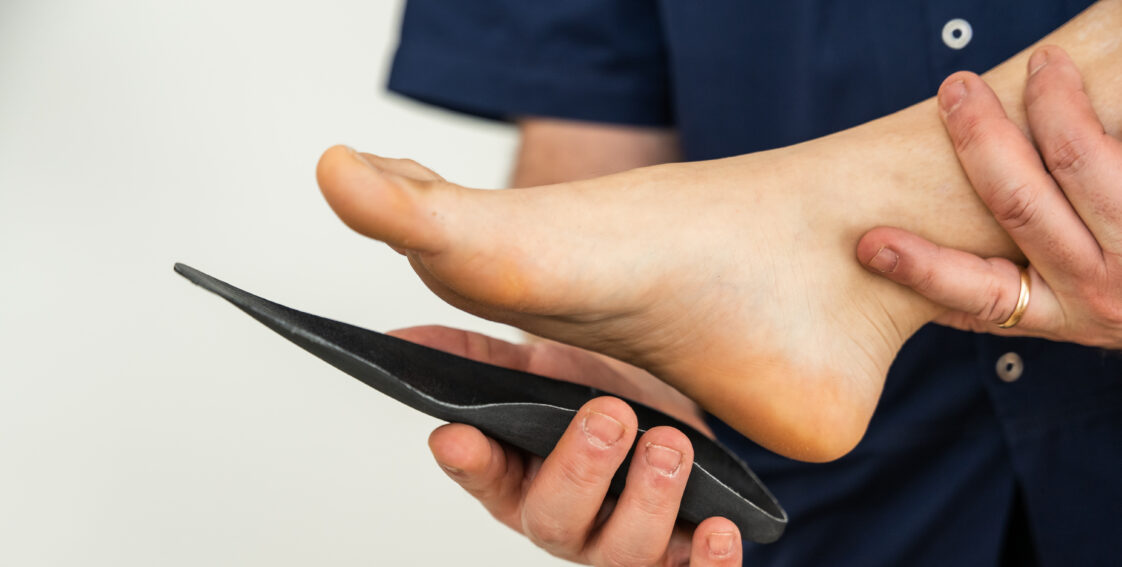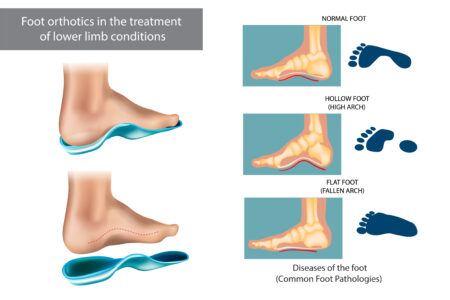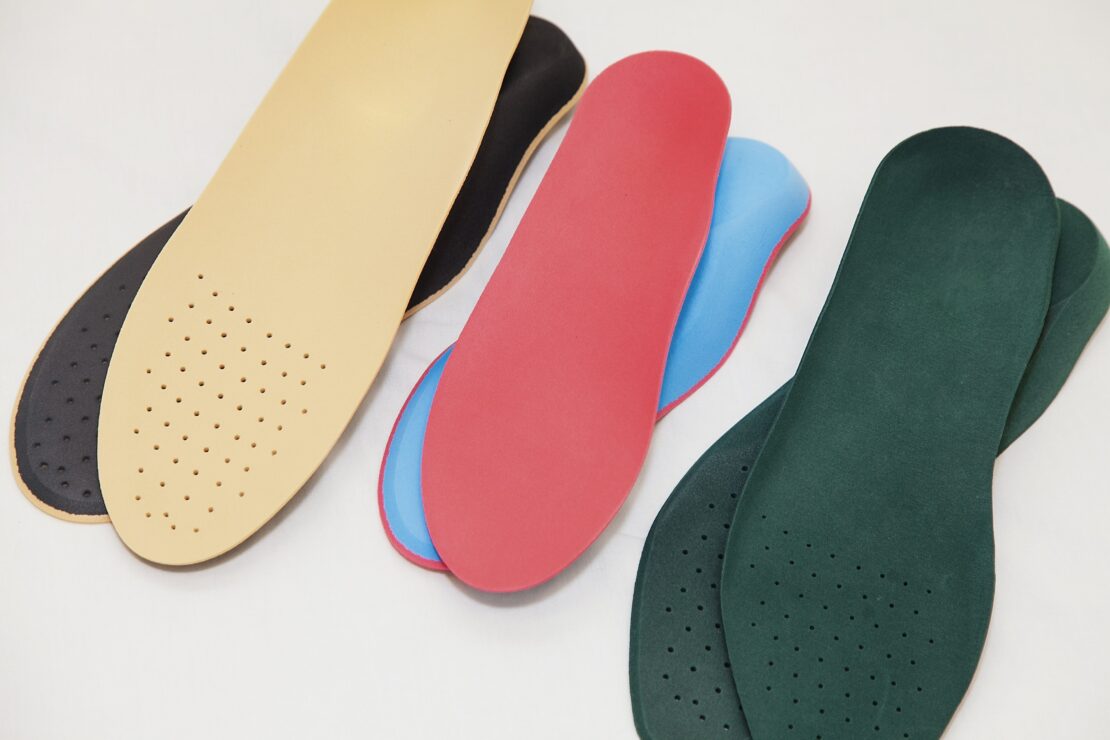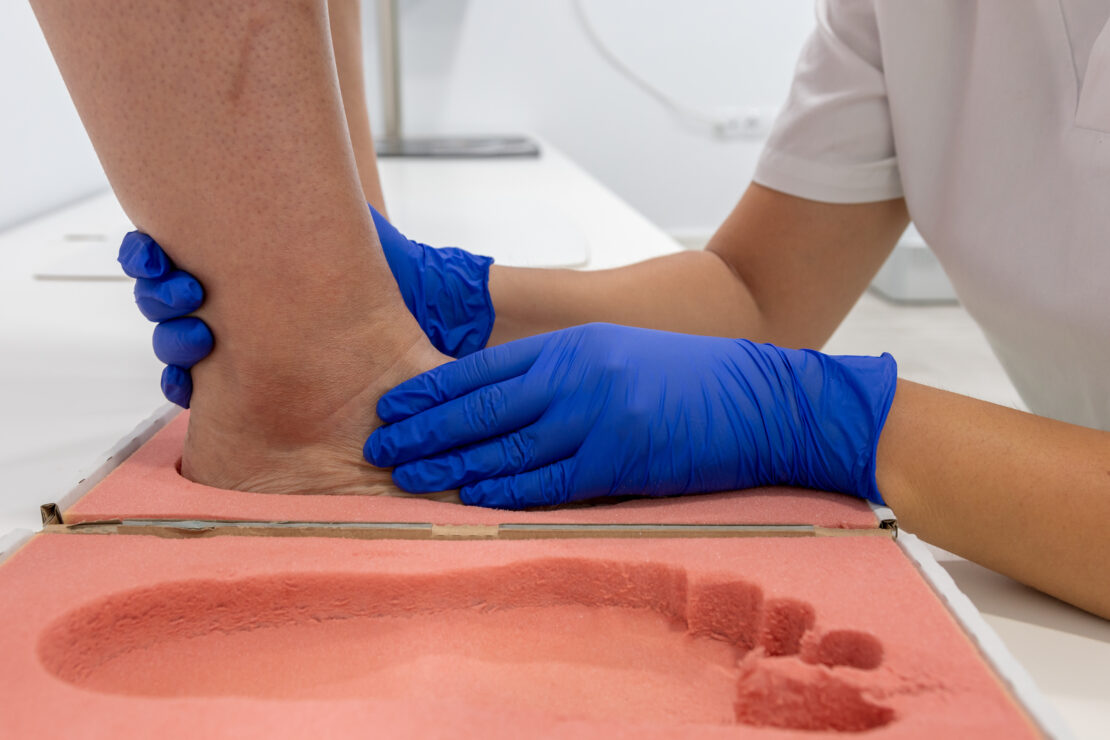
If you have chronic foot pain, chances are it won’t stop there. Many people don’t realize that untreated foot issues can be the primary cause of pain in the knees, hips, or back. If you have foot pain that keeps coming back and is affecting other parts of your body, custom orthotics might be a solution.
Orthotics refers to prescription devices that go inside your shoes to encourage proper foot alignment and support. Custom foot orthotics are specially made from a 3D impression of your feet, meaning they are tailored to fit only your body. Your foot imprint is a lot like a fingerprint—it is unique to you. When properly created and implemented, orthotic devices can improve biomechanical conditions associated with walking, standing, and running.
Conditions Commonly Treated With Custom Orthotics

Custom foot orthotics can improve several conditions, including:
- Arthritis
- Diabetes
- Traumatic Injury
- Heel Spurs
- Flat Feet
- High Arches
- Back Pain
- Bunions
- Plantar Fasciitis
- Hammer Toes
A primary care doctor can help you decide if you’re a good candidate for custom orthotics.
Benefits
- Improves comfort when walking, standing, or running.
- Reduces pain in the feet, ankles, and legs—custom orthotics absorb shock and redirect pressure to less sensitive areas of the feet.
- Enhances balance because custom orthotics allow for correct foot positioning.
- Improves athletic performance by reducing the risk of injury.
- Treats collapsed arches and high arches that can lead to other injuries, such as knee and back pain.
- Corrects abnormalities in the foot.
Types of Orthotics
There are various types of orthotics to consider. Your best fit, so to speak, will vary based on the nature and severity of your condition and your age, activity level, and other lifestyle variables.
Rigid
Rigid orthotics are primarily for walking or dress shoes. They provide a firm surface and are typically made of plastic or carbon fiber.
Semi-Rigid
Semi-rigid orthotics enhance foot balance when walking or playing sports. They are also a treatment for flat feet and in-toeing and out-toeing in children. These devices consist of soft material reinforced by a rigid surface.
Accommodative
Accommodative orthotics are specially made to treat a painful or injured area on the soles of the feet. They may also help to manage an abnormal foot function. Accommodative devices may be made from leather, cork, rubber, or foam.
Pediatric
Pediatric orthotic devices are inserts for children’s shoes. In some cases, they may include knee-high braces. The goal is to help children with injuries and certain medical conditions, such as:
- Flat Feet
- Toe Walking
- Poor Balance
- Leg Length Discrepancies
Sports
Sports orthotics target sports-related needs, including:
- Reducing the risk of injuries.
- Improving athletic performance and endurance.
- Correcting misalignment that can interfere with sports play.
- Increasing contact surface for better pressure distribution.
- Optimizing forward movement.
- Improving post-training recovery.
What to Expect During Your Visit & How the Process Works
Once the staff checks you in for your appointment, they will take your vitals and perform range of motion tests. You’ll want to wear comfortable, loose-fitting clothes for this step.
Then, the doctor will discuss your symptoms and medical history with you. After the initial consultation, the doctor will perform a comprehensive foot examination. In some cases, the doctor may order imaging tests to get a better look at the structure of your feet or to diagnose an injury or condition.
After completing the medical history, exam, and additional testing, the doctor will create a mold of your feet, which will be used to design the custom orthotic. Molding can be done in several ways. One of the most common ways is by using a 3D scanner. In this method, you place your foot on the scanner, and it creates the design for a mold.
The prescription for the custom foot orthotic then goes to a lab to be fully created. When the devices are ready, you will schedule an appointment to pick them up and ensure they fit correctly.
Cost & Insurance Coverage
The cost of your custom orthotic device will depend on many factors, including material quality and additional features like extra cushioning and special coatings for moisture control.
Be sure to check with your insurance company so you know if orthotics are covered in your policy and, if so, which types.
In addition to the common pricing factors mentioned above, keep the following in mind:
- Diagnosis: Overall foot health is a primary cost factor. The more complex your needs are, the higher the cost.
- Type of Device: For insurance purposes, orthotics generally fall into one of two categories: functional or accommodative. Functional orthotics are designed to realign the foot to achieve a certain medical outcome, typically pain reduction and restoration of normal movement. Accommodative orthotics support the foot as-is without trying to change the structure. In general, functional products tend to cost more because they must be carefully designed to achieve the desired outcome.
Schedule Your First Consultation
When it comes to your health, the sooner you get treatment, the better the outcome. If you’re experiencing severe pain or discomfort, our doctors and licensed physical therapists at Total Health Systems are here to help.
Total Health Systems is a multi-disciplinary wellness clinic in Michigan focused on delivering holistic solutions. We don’t just treat your symptoms—we help you get one step closer to living pain-free.
Schedule an appointment at one of our five locations today to see if custom foot orthotics are right for you.


